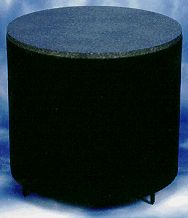Product Review -
Hsu Research HRSW12V Subwoofer - May, 1995
By John E. Johnson, Jr.
![]()

|
 |
Hsu Research HRSW12V Subwoofer. Downward firing 12" driver in ported cylindrical enclosure, separate 150 watt amplifier included, size 22.5" H (including 2.5" spiked feet) x 23" diameter, black cloth cover on sides, granite paint finish on top (light oak and dark walnut available for $75 extra), weight 50 pounds, connections for left and right inputs from preamplifier (RCA) and speakers, 91 Hz active low and high pass filter - fourth order, other crossover frequency modules available (28 - 155 Hz), $850, Hsu Research, 14946 Shoemaker Avenue, Unit L, Santa Fe Springs, California 90670, (310) 404-3848.
Prodigious bass that shakes the walls; if you want it, the Hsu Research model HRSW12V subwoofer delivers. We could stop right here, but that wouldn't be any fun, even if it would save space. The Hsu 12V subwoofer is a splendid product, and we want to explain exactly how we reached this conclusion.
Hsu Research has been making subwoofers for several years, but this is their first entry into the self powered variety. As with their other models, the 12V is cylindrical and made of cardboard. We have seen criticism of this design, but in fact, most speakers are made of MDF (medium density fiberboard), another processed wood product. If one were asked why solid wood is not used in modern designs, the answer is not because it is too expensive, but rather, solid wood is too resonant. The unique acoustical resonance of wood accounts for the sound of a guitar, as well as highly prized secrets that died with Antonio Stradivari centuries ago. A cylindrical design is also stronger than a box design, allowing for cardboard only 0.33" thick to be used, and because of the resonance properties of cardboard, it is equivalent to a much thicker section of MDF. One other feature of cylindrical designs should be noted, and perhaps it is the most important. In a square enclosure, standing waves are easily generated, and these become a problem. That is why there are so many designs on the market that move away from a simple square box. By making the sides and/or top non-parallel with the opposite side, standing wave production is reduced. So, you can see all kinds of shapes in speaker enclosures, some with sloping front, sides, top, and so on. The cylinder is ideal for minimizing standing waves, because the sides (a cylinder) are totally non-parallel. In fact, this is the fundamental reason Dr. Poh Hsu designs his subwoofers with cylindrical enclosures. The top of the enclosure consists of two 0.75" MDF sections glued together, and the bottom is a single piece of 0.75" MDF.
A 12" downward firing driver is used in the 12V. It has an impregnated paper cone and a free air resonance (fs) of 17 Hz. The 3.75" flared port tunes the enclosure to 20 Hz. The driver Q is 0.28, and the enclosure and amplifier equalization are designed so that a slightly overdamped sixth order ported system is represented.
A 150 watt (into 3 Ohms) amplifier is provided with the 12V. It is a separate component, rather than being built into the enclosure. The amplifier measures 7.5" H x 9.5" W x 5.5" D, and weighs about 12 pounds. Both the amp and the top of the enclosure are painted with Zolatone which gives the appearance of granite. The sides of the enclosure are covered with a black knit tubular sock. Three 2.5" pointed feet are provided which screw into the base and help to uncouple the enclosure from the floor.
The amplifier has connections for speakers or line level (RCA) inputs from a preamplifier (right and left channels), and the high pass outputs consist of line level (RCA) connections to a power amplifier which drives the satellites. There are switches on the amp for disconnecting the crossover filter, in case a subwoofer output on the preamp is preferred. This is especially nice when the preamp has several crossover frequencies to choose from. There is also a "soft clipping" switch that activates a circuit for protection from overload. A phase inversion (180 degrees) switch and a volume potentiometer round out the amplifier controls. The main output of the amplifier is a set of metal binding posts as are the connections on the bottom of the enclosure. Thus, a short length of speaker cable (not supplied) is required. Because the binding posts are on the bottom, next to the driver, bare wire wrap or spade lugs are the best choice. Banana plugs tend to work their way out when heavy duty sound tracks are rockin' on the home theater system.
We tested the 12V with sine waves down to 16 Hz. At such low frequencies, a great deal of air moves in and out of the port, making some noise. However, the port is flared to help reduce this. Although the system responded to 16 Hz, our tests indicated that the low 20s were a more practical limit to this subwoofer's capabilities. At 24 Hz, we measured a plus or minus 6mm maximum excursion of the cone.
Of course, music and home theater sound tracks are the real test, and the Hsu 12V passed with flying colors, or should we say, rattling windows (we used the 12V in a home environment as well as our testing laboratory, which has no windows to rattle). In fact, even the wall studs shook and creaked. This was at full output, naturally, and with a more typical signal, the 12V just sounded - plain and simple - great. The 12V blended with our reference bookshelf speakers (when playing CD music) seamlessly, without boominess. If you plan to use the unit with a subwoofer output from a preamplifier, and the entire frequency spectrum still passes through the main speakers, you should carefully consider the crossover frequency that you order with the 12V. It comes with a 91 Hz low/high pass module, but depending on your main speakers, you might want to choose a lower frequency. We have found that 60 - 75 Hz is more appropriate when good mini-monitors are used.
The Jean Guillou pipe organ transcription of Mussorgsky's "Pictures at an Exhibition" (Dorian 90117) just won't cut it without a good sub, and the 12V handled the low end pedal notes with aplomb. Home theater sound tracks such as Jurassic Park showed why a good subwoofer can make you afraid to watch TV alone at night. If you would like a suggestion for a good CD to test your present system, purchase the Telarc CD-80342, "The Great Fantasy Adventure Album". The need for a powerful subwoofer such as the 12V is plainly evident.
Dr. Hsu graciously permitted us to take one of the enclosures apart and experiment (just to see if we could improve on this already excellent design). We coated the interior walls with 5 pounds of silicone rubber caulking and stuffed the enclosure with 6 pounds of polyester fiber material. The result was a slightly tighter bass, but at the expense of frequency output at the deep end. So, our conclusion is that the unit is just fine the way it is. However, the unit is so easy to get into (by removing the bolts that attach the driver), it just begs for fiddling with by DIYs ("do it yourself"), and owners of the 12V might want to stuff a little more damping material (one 20 ounce bag would do nicely) between the port and the wall of the enclosure. No need to glue it in right away because it will be held in place by the port and enclosure. If you don't like the result, you can easily take it back out again (cost of tweak: $1.79).
In sum, what can we say but that the 12V is one heck of a thunder buster. And hey, you don't have to play it loud all the time. A good sub will also help with the low notes on a piano when you are listening to some Chopin.
John E. Johnson Jr.
Editor-in-Chief
![]()
© Copyright 1995, 1996, 1997
Secrets of Home Theater & High Fidelity
Return to Table of Contents for this Issue.

